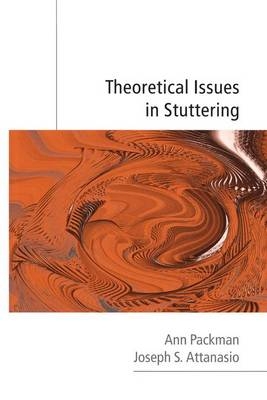
Theoretical Issues in Stuttering
Routledge (Verlag)
978-1-138-87745-0 (ISBN)
- Titel ist leider vergriffen;
keine Neuauflage - Artikel merken
Theoretical Issues in Stuttering provides a comprehensive account of the contribution of theory to understanding and managing stuttering. It covers an impressive range of topics including a description of both past and current theories of stuttering, placing each within the relevant historical context. In addition, the authors evaluate the explanatory power of such models and provide a detailed exploration of the implications of these models for the practitioner.
Theoretical Issues in Stuttering aims to fill a gap in the literature on the subject of stuttering theory and to act as an invaluable resource for speech-language pathologists, lecturers and advanced students of speech and language pathology.
Ann Packman is Senior Research Officer at the Australian Stuttering Research Centre, at The University of Sydney. She has worked in the area of stuttering for over 30 years, as a clinician, an educator and a researcher. Joseph S. Attanasio is a Professor of speech-language pathology in the Department of Communication Sciences and Disorders at Montclair State University. His published works include articles in the Journal of Speech and Hearing Disorders and the American Journal of Speech-Language Pathology.
Chapter 1: The Search for Understanding. Seeking Explanation. Causality and Stuttering. Causality: Issues of Logic. A Realist View of Causality. Establishing Cause: Necessary and sufficient conditions. Distal and Proximal cause.Definitions. Fallacies of Causal Reasoning. Chapter 2: The Role of Theory in the Sciences. Theory in the Physical Sciences. Theory in the Human Sciences. Chapter 3: Evaluating Theories. Testability and Falsifiability. Explanatory Power. Parsimony. Heuristic Value. Summary and Discussion. Chapter 4: Historical Perspectives on Selected Past and Present Theories of Stuttering: Influences of the Zeitgeist. Psychology: A Very Brief History. L.E Travis: Cerebral Dominance and Stuttering. Psychoanalysis and Stuttering. W. Johnson: Culture, Language and Stuttering. Chaos Theory and Stuttering. Conclusion. Chapter 5: What Should a Theory of Stuttering Explain? The Problem of Definition. The Topography of Stuttering. Onset and Development. Natural Recovery. Genetics. Variability. Chapter 6: Theories of Stuttering: Speech Motor Control The Interhemispheric Interference Model. Chapter 7: Theories of Stuttering: Systems Control Modelling. Sensory-motor Modelling Theory. The Neuroscience Model. The Variability Model (Vmodel). Chapter 8: Theories of Stuttering: Cognitive and Linguistic Processing. The Neuropsycholinguistic Theory. The Covert Repair Hypothesis. Suprasegmental Sentence Plan Alignment Model. Chapter 9: Theories of Stuttering: Multifactorial Models. The Demands and Capacities Model. Dynamic Multifactorial Models. Chapter 10: Theories of Stuttering: Anticipatory Struggle. Anticipatory Struggle Hypothesis. Chapter 11: Theories and Treatment. Introduction: Discussion of Review of Theories.Therapy Based on Theory. Effective Therapy as Confirmation of Theory. The Proof of the Pudding is in the Eating: The Primacy of Evidence. The Necessity of Theory for Treatment. A theoretical Treatment: An Example. Theories as Potential Sources of Error in the Selection of Treatment. From Treatment to Theory. Postscript Chapter 12: Final Comments. References.
| Verlagsort | London |
|---|---|
| Sprache | englisch |
| Maße | 156 x 234 mm |
| Gewicht | 295 g |
| Themenwelt | Geisteswissenschaften ► Psychologie ► Allgemeine Psychologie |
| Geisteswissenschaften ► Psychologie ► Verhaltenstherapie | |
| Medizin / Pharmazie ► Gesundheitsfachberufe ► Logopädie | |
| ISBN-10 | 1-138-87745-X / 113887745X |
| ISBN-13 | 978-1-138-87745-0 / 9781138877450 |
| Zustand | Neuware |
| Haben Sie eine Frage zum Produkt? |
aus dem Bereich


